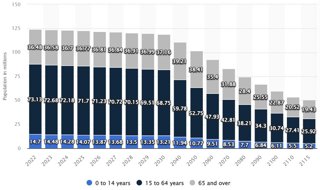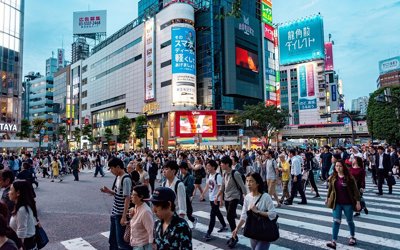Introduction
The Japanese government has announced that in April 2023 families will receive 1m yen (~£6,414) per child if they choose to move out of the capital city, Tokyo.
While there has been a relocation incentive in place since 2019, this is a substantial increase from 300,000 yen (~£1,926) in previous years. Those that take the money must embrace the provincial life for a minimum of five years or refund the state.

Figure 1 busy Tokyo © Sofia Terzoni, Pixabay
The background
Japan is facing a multitude of problems: an aging population, waning regional villages, declining fertility rates and – due to the very low birth rate – falling general populations.
Urban sprawl and rural emptying have been a feature of globalisation and urbanisation. In the twenty-first century, as family size has shrunk dramatically, the benefits of an ageing population (experience and knowledge, wealth, and voluntary work) have faded.
For many post-war decades in the twenty century, Japan led the way in East Asia. However, in 1974 the fertility rate fell below the population replacement rate of 2.1. Since then, the fertility rate has continued to slow down and in 2008 Japan registered its first peacetime population decrease.
Conversely, the population of Tokyo has risen over time. The greater Tokyo metropolitan area has an estimated population of ~37 million. This means that around one third of Japan’s population live in the Tokyo region. Elsewhere, hundreds of Japanese rural towns and villages are struggling with an exodus of local population.
The strategy
Japan’s rural towns and villages have been emptied out, leading to failing business and staff shortages, while Tokyo’s status as a magnet for economic activity and migration has strengthened. The aim of the initiative is to encourage 10,000 Tokyoites to relocate to rural areas by 2027. This unique initiative intends to reverse population decline in rural areas by depopulating urban areas. It also aims to encourage an injection of youth and entrepreneurialism into the remote areas of Japan.
The Japanese government is worried about Japan’s persisting ageing population. The intention of the scheme is that families will be encouraged to create larger families outside Tokyo and prevent the extinction of rural towns.
The future
Between the 1950s and 1980s, after several decades of population and industrial growth, the Japanese economy began to falter. The period between 1991 and 2001 is now called ‘the lost decade’ and projections for the twenty-first century predict continuing decline.
In 2022, the over-75s in Japan accounted for more than 15% of the population for the first time. The future population of Japan is forecast to shrink considerably, and state intervention is now a pressing priority.

Further work
-
The Guardian Japanese government offers families 1m yen a child to leave Tokyo
-
The Financial Times Japan to offer families ¥1mn per child to leave Tokyo | Financial Times
-
CNN Tokyo is so crowded the government is paying families to leave
-
PWC Smart cities in 2050: Rebuilding the future of Japanese cities
-
Statista Japan Forecast of the total population in Japan from 2022 to 2115, by age group
